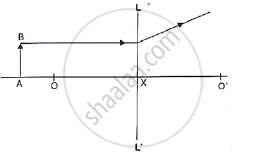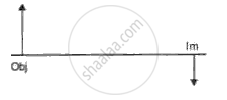Advertisements
Advertisements
प्रश्न
In the following diagram, L1 and L2 are the two convex lense placed at separation equal to the sum of focal lengths of the two lenses. A and B are the two rays of light incident on the lens L1. Complete the path of rays till they emerge out of the lens L2.

What principles have you used in completing the diagram?
उत्तर
The complete ray diagram is shown below.

The following two principles have been used in completing the diagram:
(i) A ray of light incident parallels to the principal axis after refraction from the convey lens passes through the focus.
(ii) A ray of light incident on the convex lens through its focus after refraction becomes parallel to the principal axis of the lens.
APPEARS IN
संबंधित प्रश्न
Study the diagram shown in Fig. 5.56
what are the two other characteristics of the image?

A ray of light incident at the optical centre of lens, passes undeviated after refraction.
In the following diagram ., the object and the image formed by the respective lenses are shown. Complete the ray diagram, and locate the focus. Find the focal length of the lens.

Make the correct choices in the following items :
The image formed by a diverging lens, shown in fig, , is

A lens forms the image of an object placed at a distance of 45 cm from it on a screen placed at a distance 90 cm on the other side of it. Name the kind of lens.
State the nature and position of the object on the principal axis to obtain a real and magnified image.
When does a ray of light falling on a lens pass through it undeviated?
Draw a ray diagram to show the image formed by a convex lens when the object is placed between F and 2F.
